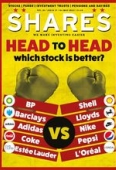Archived article
Please note that tax, investment, pension and ISA rules can change and the information and any views contained in this article may now be inaccurate.
How to invest in growing demand for private healthcare and virtual doctors

Are you fed up with trying to get a doctor’s appointment or a date for surgery on the NHS? You are not alone.
A new study by YouGov found that one in eight Britons turned to private healthcare over the past 12 months. The trend is driven by a struggling NHS which has seen patient waiting lists swell to
7.2 million, almost double their pre-Covid level.
The study found that 13% of respondents had used private healthcare in the last year for themselves or someone in their household. A further 27% considered it. That implies a real incentive for investors to see which stocks might be relevant to the private healthcare theme.
The obvious stock on the London Stock Exchange is Spire Healthcare (SPI), one of the largest private healthcare providers in the UK. The group works with over 9,000 consultants and generates revenues from insured, self-pay and NHS referred patients.
In March, Spire reported an 8.3% rise in revenue for 2022 and moved from a loss to a profit, citing strong demand for private healthcare. That chimes with comments from Australian listed Ramsay Healthcare (RHC:ASX) which in February reported better results for its UK hospital operations.
Analysts at Liberum believe the combination of rising pressure on the NHS and buoyant self-pay rates which are back above pre-pandemic levels should continue to underpin growth in the UK healthcare market for the next two years.
While this should provide a decent tailwind for Spire, an additional attraction of the shares is a potential takeover by its largest shareholder Mediclinic International (MDC) which made an unsuccessful bid at 315p per share in 2017.
Mediclinic itself is being taken over in a £3.7 billion deal by a consortium comprising Remgro (REM:JSE) and MSC Mediterranean Shipping which is due to close mid-year. This consortium will inherit a 29.7% stake in Spire as part of the acquisition of Mediclinic and it is feasible to suggest they might want to buy the remainder of the business.
Ramsay tried to buy Spire a few years ago at a level above the current share price, but this was voted down by shareholders. The predator then become prey when Ramsay received a takeover bid from private equity group KKR last summer. These actions imply considerable corporate interest in the sector.
SPIRE’S SHARE PRICE PERFORMANCE
Spire’s shares are trading roughly where they were when they listed on the stock market in 2014 at 210p per share which means they are some 45% below the heights of September 2016.
It’s faced several challenges as a listed company. There were concerns regarding a rogue surgeon working in the NHS and at two of Spire’s hospitals. Questions were asked about Spire’s internal controls, hurting its reputation. There were also concerns about ‘Care Quality Commission’ or CQC ratings as some private medical insurance providers do not allow their patients to be treated in facilities that are not rated ‘good’ or ‘outstanding’.
Work has gone into addressing both issues albeit Covid has more recently disrupted earnings, so Spire’s turnaround story is taking longer to play out than previously expected.
DIFFERENT THIS TIME?
Odyssean Investment Trust (OIT) has a stake in Spire and its fund manager Stuart Widdowson believes the current share price does not reflect the potential for the group.
Widdowson told Shares: ‘A combination of growing private demand (both self-paid and insured) along with support to the NHS will, we believe, result in a favourable demand environment for providers like Spire over the medium term.
‘Spire has a strong market position as a leading operator of private hospitals in the UK and has a management team that we rate highly.’
WHAT ARE THE GROWTH DRIVERS?
Liberum estimates the UK private acute healthcare market could see an acceleration in growth from the 4.8% a year seen over the past 18 years to around 7% a year over the next three years.
Helping reduce the bloated NHS waiting list backlog could be a driver of more engagement and referrals subject to acceptable pricing being agreed.
Liberum cites a 2022 study which showed that at current rates of productivity the NHS backlog would never be cleared.
Applying productivity levels achieved by the top 25% of national health trusts would clear the backlog in nine years while productivity levels at the very best performing trusts would clear it in under a year.
At the same time Liberum notes the PMI (private medical insurance) segment of the market is showing signs of life after many years of stagnation. Data provider Mintel estimates the market grew 6% in 2022 and Spire generated 13.7% growth from the PMI market last year.
The recent YouGov study showed many people appear to be voting with their feet and choosing self-pay and private medical insurance where financially feasible. Liberum expect self-pay market volumes to grow in low-single digits over the medium term rising to mid-single digits with the benefit of stronger pricing.
Unlike the PMI market self-payers have relatively little pricing power which means the provider can set the price for all procedures bar the consultancy fee.
In recent years the private sector has become an established NHS provider which notably ‘stepped-up’ during Covid. While there is probably widespread mistrust from within the NHS about using the private sector, there appears to be a real need for help.
DOUBLE DIGIT PROFIT GROWTH
Spire seems likely to benefit from increased spending on private sector healthcare given its diversified national footprint and leading market share.
Liberum estimates revenue will grow at a compound annual growth rate of 7.6% a year over the next couple of years while EBITDA (earnings before interest, tax, depreciation, and amortisation) is seen growing at 11.2% a year as margins increase. The forecasts assume no significant commissioning by the government of NHS work to the private sector.
Although there are risks considering the complicated nature of the business and unpredictable end markets, overall, the potential rewards look attractive.
Online doctors: great idea, bad investment?
Pre-pandemic, most people would assume the only way they could see a doctor was by visiting their local surgery. Thanks to advancements in technology and a structural shift in the market towards more online services, it is now possible to see a doctor via web conferencing services.
There are several stocks relevant to this trend, albeit they are overseas-listed names rather than on the UK market. While their services are plugged into an interesting part of the market, the share price performance hasn’t always been good.
Babylon (BBLN:NYSE)
Better known as Babylon Health, the company provides access via a phone app to GPs, physiotherapists, nurses and pharmacists.
The company grew revenue 3.5-fold in 2022 to $1.11 billion, with the UK operations the most mature part of its business. However, the group as a whole remains loss making. It hopes to become profitable on an adjusted EBITDA basis by mid-2024.
As an investment, Babylon has been a disaster. Its share price has fallen by 97% since joining the US stock market in 2021, floating at the top of the market for growth stocks and just at the point when investor appetite started to dwindle for loss-making businesses.
Teladoc Health (TDOC:NYSE)
Its share price soared during the pandemic as virtual healthcare services were in hot demand. However, like many Covid winners, the share price has since lost all its gains, and more.
In the thick of the pandemic, Teladoc bought rival company Livongo for $13.9 billion. It paid too much and the company recorded $13.4 billion of impairment charges in 2022 mainly linked to the acquisition.
On a group basis, net losses ballooned in 2022 from $428.8 million to $13.66 billion.
Teladoc said in February that it saw ‘healthy demand’ for solutions that provided better access to healthcare services and lowering the cost of receiving help. The big problem is that as a business it doesn’t make any money. Companies with a good narrative no longer cut the mustard, they need to make a profit to interest investors these days.
Important information:
These articles are provided by Shares magazine which is published by AJ Bell Media, a part of AJ Bell. Shares is not written by AJ Bell.
Shares is provided for your general information and use and is not a personal recommendation to invest. It is not intended to be relied upon by you in making or not making any investment decisions. The investments referred to in these articles will not be suitable for all investors. If in doubt please seek appropriate independent financial advice.
Investors acting on the information in these articles do so at their own risk and AJ Bell Media and its staff do not accept liability for losses suffered by investors as a result of their investment decisions.
Issue contents
Case study
Feature
Great Ideas
News
- Cloud computing, not artificial intelligence, is what’s really driving big tech earnings
- HSBC shares leap as profits triple and firm announces $2 billion buyback
- Meta Platforms’ shares continue to soar on AI hype and cost cuts
- Shares in Ocado are down 44% in 12 months as the company closes key facility
- Could the sustained rise in food prices become a political issue?

 magazine
magazine








